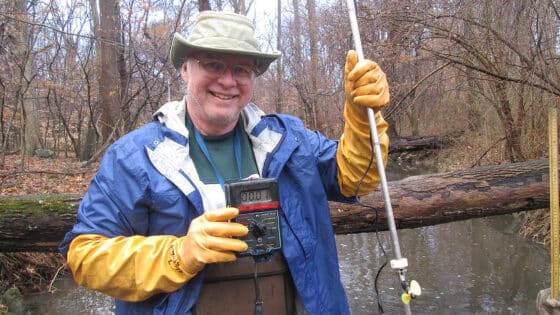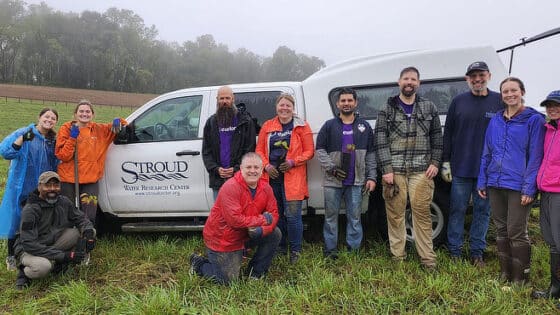Message from the Director
It’s About Time
“Time,” wrote Henry David Thoreau, “is but the stream I go a-fishing in.” Here at Stroud Water Research Center, time obviously isn’t the only stream we wade into. But it is a critical aspect of all our work, and we encounter it in many different ways and guises. One thing, however, never changes — we can’t seem to find enough of it.
Time is one of our greatest assets. It reflects the longevity of our collective experience and the continuity of our experimental data. Hard as it is for some of us to believe, we have been in the business of scientific research for thirty-four years. We have a continuous thirty-year record of the physical, chemical, and biological characteristics of the White Clay Creek experimental area. Our senior staff brings over 120 years of experience to bear on streams and rivers.
Time is continuity, as evidenced by Tom Bott’s thirty-three years, Sally Peirson’s twenty-eight years, and the average tenure among our senior scientists of over nineteen years.
Time is a gift our volunteers have given us selflessly over the years, from monitoring streams to raising funds.
But in today’s world, time can also be a liability, as we all must act under its constraints. People want fast answers to pressing questions about the Earth’s water, yet gathering, sorting, analyzing, and truly understanding the knowledge we seek takes months and often years. There are no shortcuts, and so often, there simply isn’t the time to do all we want and need to do.
Finally, time is a critical aspect of our research. Everything from algal metabolism to stream flow is expressed in terms of time, and our sampling protocols range from an hour for bacterial studies to a decade for stream channel movement.
We have never had an official clock at the Stroud Center, yet time and the perspective it gives permeate our lives: How fast is the instrument (response time)? How good is the sample (holding time)? How productive is the employee (time sheets)?
Whether we measure by the millisecond or the millennium, we strive to make our research timely and ensure that it stands the rigorous test of time.
Bern Sweeney
Director
Water for Gotham
The Stroud Center Tackles New York City’s Internationally-Envied Water System
As the Catskill mountainsides turn golden-red, Stroud Center scientists and technicians are racing to finish their first season of sampling the streams and reservoirs that give clean water to some nine million New Yorkers.
This is a massive and consuming undertaking for the Stroud Center. It involves all staff members, in addition to the six new scientists and technicians hired for this job.
The story of how the Stroud Center became involved with one of the world’s largest and most sophisticated city water systems goes back more than a year. A visiting nephew of Stroud board co-chairman John Fisher saw the Stroud Center’s video “Every Drop Counts.” Impressed, he took the video back to show his colleagues at Hudson Riverkeeper. Among them was Robert F. Kennedy Jr., chief prosecuting attorney for the environmental organization that played a leading role in the cleanup of the Hudson. The video stirred him enough to call and order several hundred copies.
A trade was made—Riverkeeper got the videos, and Mr. Kennedy drove down to Chester County, Pa., to open the Stroud Center’s research streamhouse last fall. This also gave him a chance to see and hear firsthand about drinking water projects the Stroud Center has been doing elsewhere.
One thing led to another, and by December of last year, Stroud Center director Bernard Sweeney was in Albany presenting water quality monitoring ideas to senior officials of New York State’s Department of Environmental Conservation. Also impressed, they asked Stroud Center scientists to submit their ideas in the form of a proposal, which they did.
In April, after several informational meetings with New York and federal officials and other interested parties, funding was approved, and the Stroud Center was contracted to do a three-year research project. The following month the weekly trek to the Catskills began. By summer’s end, the field workers were on intimate terms with picturesque trout streams — or “kills” as they were named by early Dutch settlers.
The job is immense. New York City draws its water from a network of rivers, streams, and reservoirs in the watersheds of the Hudson and Delaware rivers. Hundreds of streams feed the system’s 18 collecting reservoirs and three lakes that hold about 548 billion gallons. The system watersheds cover 1,969 square miles, with the outer edges lying 125 miles from Manhattan.
The water flows by gravity through underground aqueducts to two balancing reservoirs and four distributing reservoirs, from which an average of about 1.2 billion gallons are used daily by New York City dwellers. Fifty-six upstate cities, towns, villages and water districts draw another 123 million gallons.
New York City’s water, considered among the cleanest and best tasting of any city in North America, is internationally envied. What’s more, the water is unfiltered. And most interested parties want to keep it that way — which is why the Stroud Center is involved.
The problem New York faces is that federal regulations now insist on filtration for communities that use surface water sources. But a water authority can avoid filtration if it demonstrates to the EPA that it can “maintain a watershed control program which minimizes the potential for contamination by Giardia cysts and viruses in the source water.” (Giardia are microorganisms that cause painful intestinal sickness.)
One part of the system is already beyond filtration avoidance. The once rural East-of-Hudson Croton watershed is fast turning into a sprawling suburbia, and the Environmental Protection Agency has ordered New York to filter this section which provides only 10 percent of the city’s water. A Croton filtration plant will cost $687 million — relatively cheap next to the estimated $6 billion cost (plus $300 million a year to run) of filtration for the Catskill-Delaware system, which provides 90 percent of the city’s water.
Not surprisingly, the city has decided it would rather spend $1.5 billion over 10 years implementing a watershed management strategy than face the high costs of filtration.
The management plan is part of a Memorandum of Agreement signed in 1997 by the city, Catskill-Delaware watershed communities, EPA, New York State, and environmental organizations, including the Hudson Riverkeeper.
Agreement notwithstanding, implementation of the watershed management plan remains an uphill battle for New York City. Residents of the watersheds are historically hostile to a city whose reservoirs have displaced thousands of families – living and dead – and disrupted lives since the first reservoir was built on the Croton more than 150 years ago. Farms and whole towns were taken over by forced condemnation, cemeteries were moved, and communities were destroyed. Now, any action the city takes is often greeted with deep hostility and suspicion, as the Stroud sampling crews have experienced in the field.
Although most property owners have readily allowed Stroud Center research teams to cross their land, some have refused, expressing their anger at interference with their land and lives by “outsiders.”
Obstacles aside, Stroud Center field workers are bringing in thousands of New York water samples.
Now the lab work begins.
Wonderful Willowdale
Beautiful Day at the Races
A record crowd of 100,000 enjoyed a spectacular day at this year’s eighth running of the Willowdale Steeplechase.
Willowdale is fast becoming the place to celebrate Mother’s Day, beginning a new tradition for many families. The day not only offers a unique setting for corporate entertaining; it also provides a variety of activities for all ages, making it the perfect family event.
More than just steeplechase racing, Willowdale’s stable of events includes an antique car display, the popular Jack Russell terrier races, free pony rides for the children, and lots of food and shopping.
A special treat for children is the educational “ECS Kids’ Alley” tent. Here, Stroud scientists, along with a crew of dedicated volunteers, tutor children through the “Stream Day” exhibits, teaching them about the science and importance of streams and watersheds.
A favorite among adults is the tailgate competition sponsored by The Philadelphia Inquirer.
This year’s theme was “Famous Bodies of Water,” inspired by the Stroud Center, the event’s beneficiary. Entries featured lavish decorations and creative costumes, including the Caribbean, the Nile, and “Infamous Bodies of Water.” The winner was “The Chesapeake Bay,” a splendid panorama of the bay complete with steamed crabs and a sailboat by Laura Rivell of Kennett Square.
In addition to record-setting crowds and weather, Willowdale also set records for the number of reserved parking places sold — with spaces already filling up for next year’s race.
While the Willowdale Steeplechase takes place in just one day, the organizers hold events throughout the year to provide ongoing visibility for the big race day and for the Stroud Center. If you missed the educational panel night, the preview party, the silent auction, the races, or any of the other Willowdale events, you’ll want to add them to your calendar for the upcoming 2000-2001 season. Willowdale offers many opportunities for involvement, from spectator to volunteer.
Profile
Amanda Cabot and Peter Kjellerup
It didn’t take long for Amanda Cabot and Peter Kjellerup to be drawn to the Stroud Water Research Center.
“When we started to look around the area, the more we learned about the Stroud Center, the more impressed we were with what they were doing,” said Mr. Kjellerup. We felt very lucky to have them in our backyard.”
Ms. Cabot said they wanted to support nature preservation, but she found it difficult to understand what big organizations like the Nature Conservancy do.
“But with the Stroud Center, it is very easy to see,” said Ms. Cabot.
They could see the value of the Stroud Center’s research, as well as the impact of spreading the word to teachers and children through its education program.
So they became involved with Stroud programs and seminars, and they earmarked a generous donation from the Virginia Wellington Cabot Foundation, a philanthropy set up by Ms. Cabot’s grandmother.
The donation went to the Stroud Center’s education endowment, which allows Stroud Center educators to develop new curricula and products that will reach larger audiences. One successful example is the Leaf Pack Kit which is being used by teachers around the country.
Ms. Cabot and Mr. Kjellerup settled in southern Chester County in 1982 when they built Five Star Farm, a dressage and horse breeding center on Hood Road in West Marlborough Township.
While at the farm, they started a small service for their students that grew into the North American distribution center for Dansko shoes, the popular Danish clogs.
The Cabot-Kjellerups sold 50 pairs in 1990. Last year their distribution center in Jennersville sold 600,000 pairs of shoes throughout North America.
The business grew at about 75 percent a year, “which is easy to do when you start with 50 pairs,” said Mr. Kjellerup with a chuckle.
They sold Five Star Farm in 1997, and now they are expanding their Dansko distribution — physically and virtually — with an addition to their already sprawling building in Jennersville, Pa., and a Dansko.com outlet in cyberspace.
As busy as they are, they still have time to be involved with neighborhood work — and the Stroud Center is a big part of that.
Like what you’ve read? Subscribe to our e-newsletter for more!



